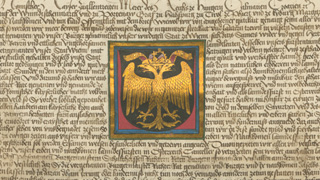The late medieval Period - History of Vienna
The late Middle Ages deserve to be called a heyday of burgher autonomy although conflicts with the sovereigns - to wit the Habsburgs from 1276/83 - recurred again and again. It is interesting to note in this context that the Habsburgs lost the imperial crown upon the death of Frederick the Fair (1330) for more than a century. They did not regain it until 1438, when Albert II came to power. In the 14th century, the cityscape was refashioned in Gothic style. This appearance was to prevail until the early 17th century. The most obvious example is doubtless the redesign of the parish church of St. Stephen's, which did not become a bishopric until 1469. The intellectual appeal of the city, which was largely dominated by the Habsburg court, was dramatically enriched with the establishment of the University of Vienna in the 14th century still.
In the late Middle Ages political and social tensions among the burghers of Vienna often mirrored dynastic quarrelling within the House of Habsburg. Nevertheless the city was spared the kinds of constitutional conflicts known from many other European cities. On the contrary, 1396 saw the number represented within the city government of various groups of burghers, especially the so-called "Erbbürger", or patricians, as well as tradesmen and craftsmen set down in a well-regulated way.
Trade
The economic mainstay of the city was, on the one hand, trade, and, on the other hand, wine-growing. Wine was the principal export, and this considerable wine production was protected by import bans on foreign, particularly Hungarian, wines. With this in mind, it is hardly surprising that the political unrest of the 15th century, beginning with the Hussite Wars and including the strife between Emperor Frederick III and his brother, Archduke Albert VI, and the Hungarian occupation of Vienna under King Matthias I Corvinus (1485 to 1490), affected these very pillars of Vienna's economy drastically. Especially the "Stapelrecht" was becoming more and more ineffective. The pressure exerted by foreign tradesmen who had been doing business in the city for a long time as well as the growing dependence of the Habsburgs on the financial prowess of powerful trade dynasties such as the Fuggers eventually prompted Emperor Maximilian to repeal the privilege in the early 16th century.
City of Vienna | Municipal and provincial archives of Vienna
Contact form

